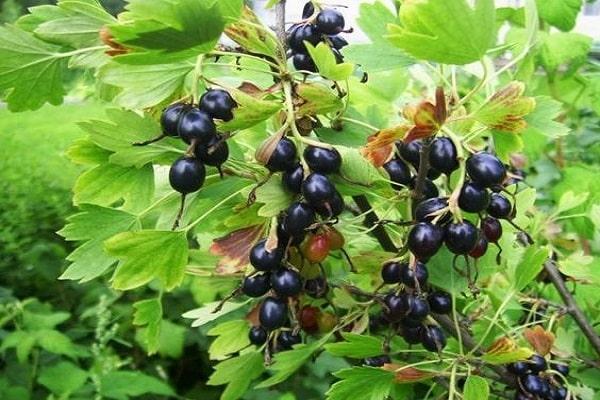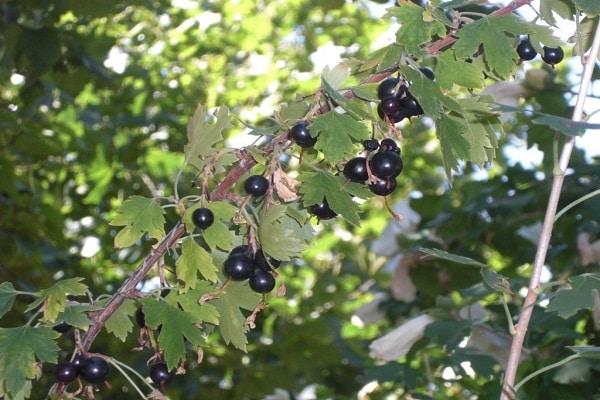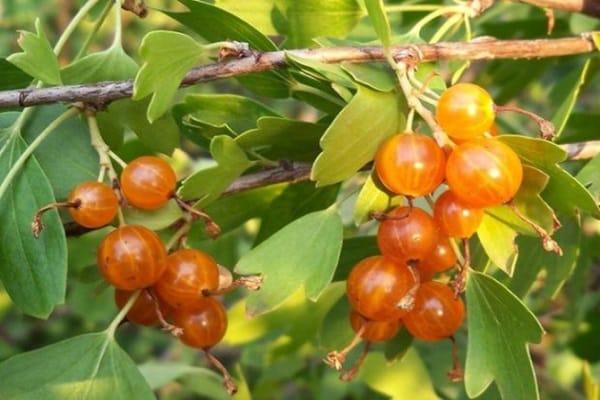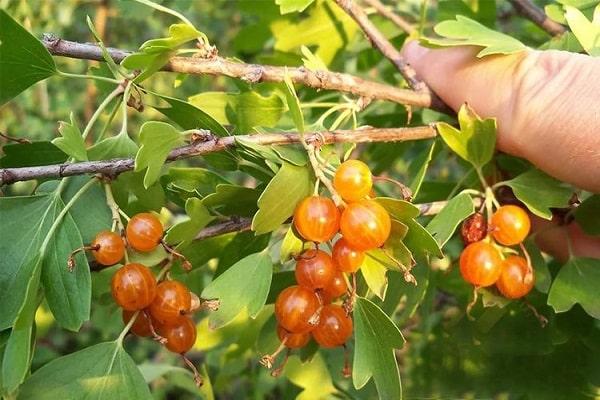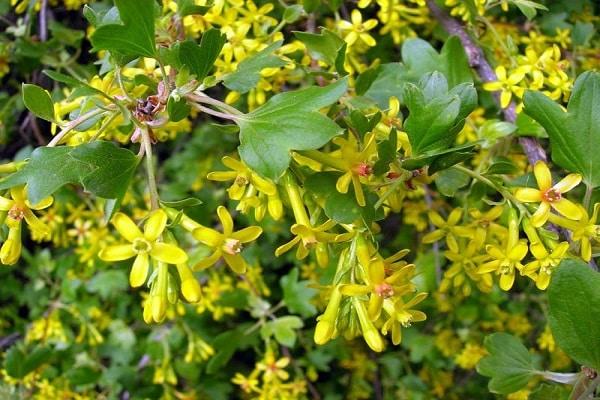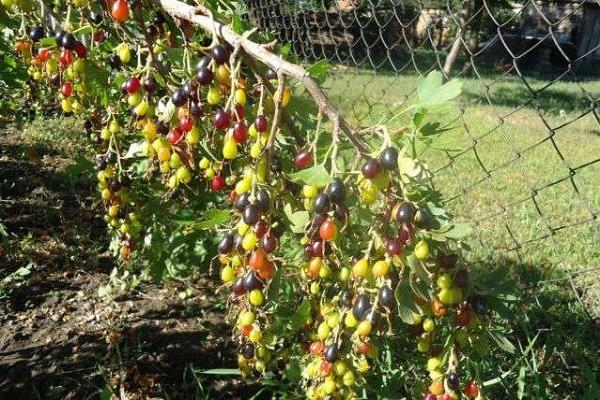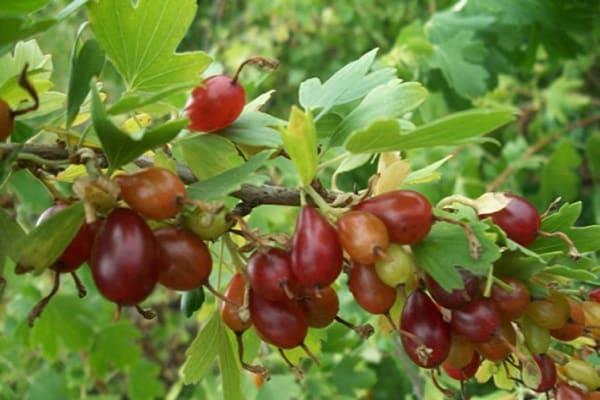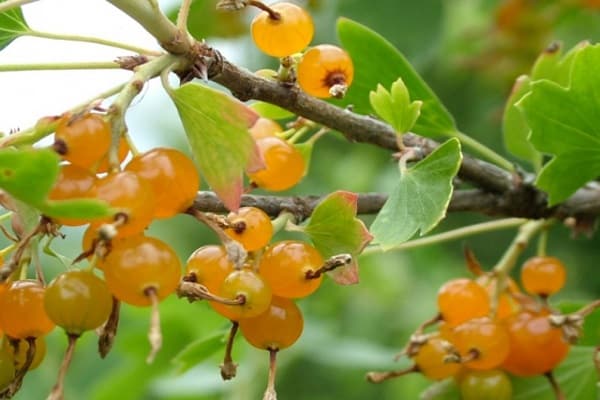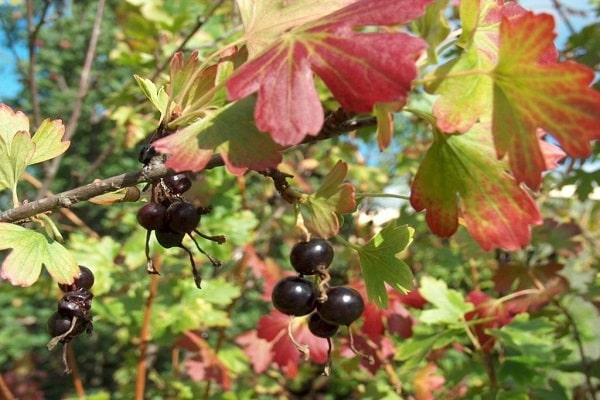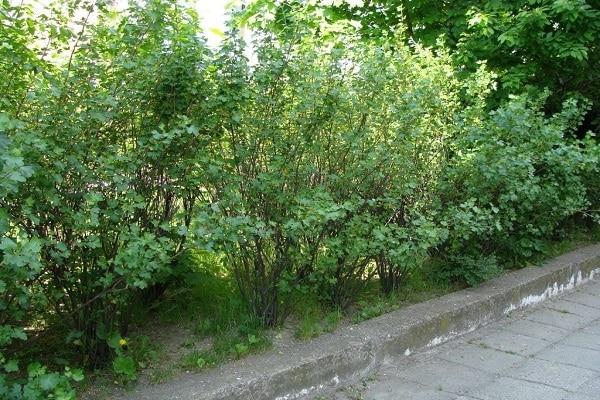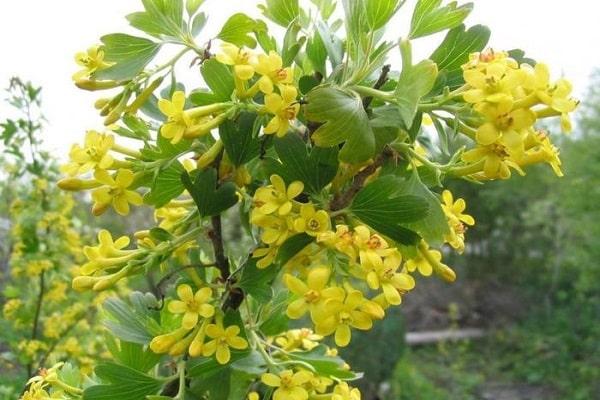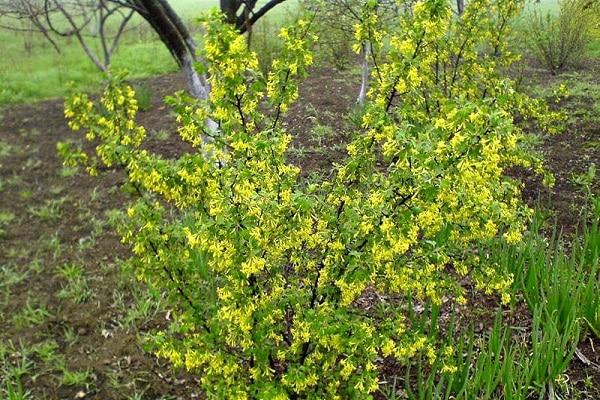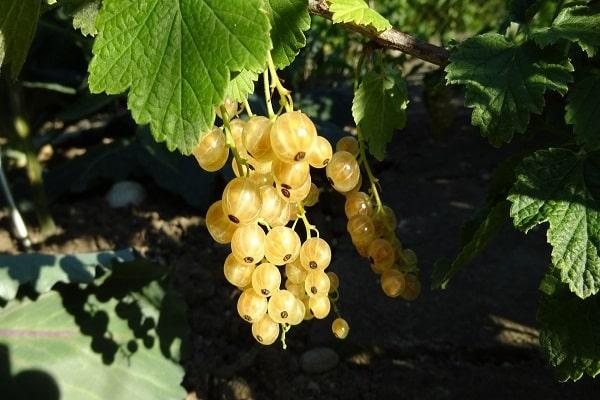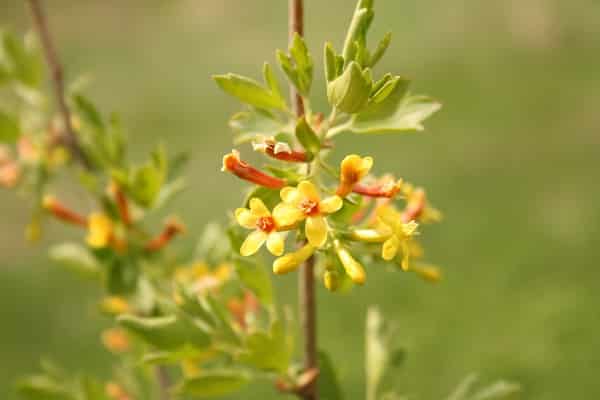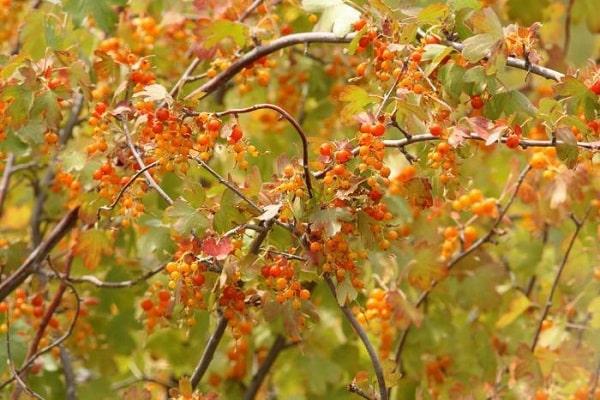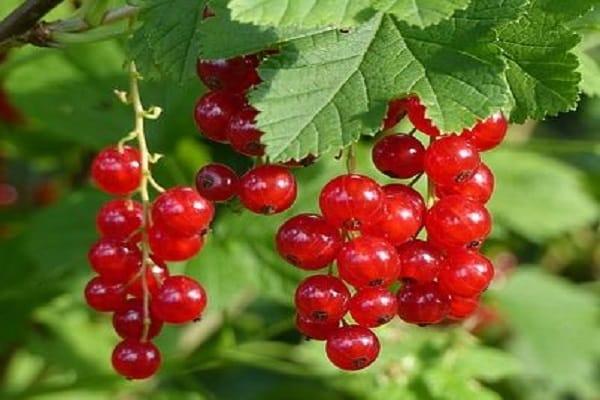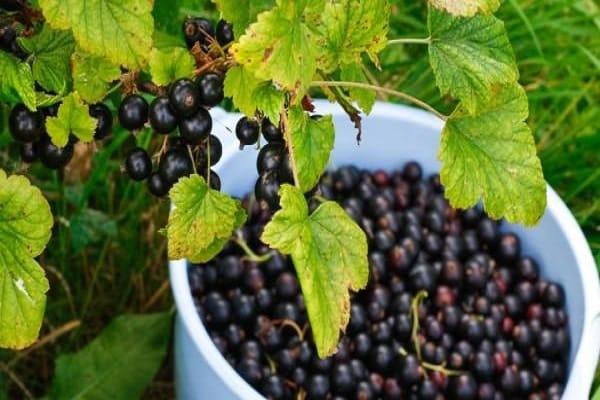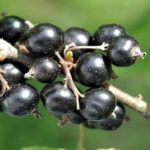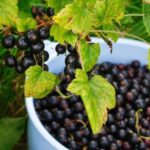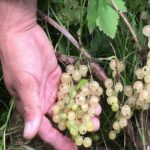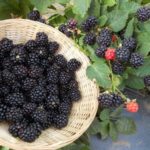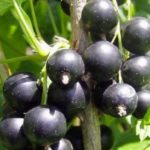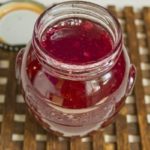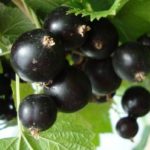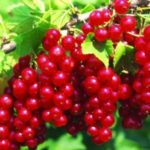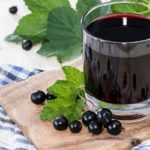Unfortunately, it is difficult to find golden currants in Russian gardens. She deserves attention. The berries are healthy and have an original blueberry flavor. Bushes are decorative and can decorate any garden, country house yard, or city square.
- Advantages and Disadvantages of Culture
- External description and characteristics of golden currant
- What are the benefits of sunberry?
- Application
- As a fruit and berry crop
- Use in landscape design
- How to grow golden bush
- Suitable climate
- Optimal timing
- Site selection and landing scheme
- Principles and nuances of care
- Watering
- Application of fertilizers
- Digging row spacing
- Weeding and loosening
- Forming a currant bush
- Treatment against pests and diseases
- Features of culture propagation
- Diseases and pests characteristic of the variety, their control
- Common spider mite
- Currant bud mite
- Great currant aphid
- Anthracnose
- Septoria
- Glass rust
- Popular varieties
- Muscat
- Shafrak
- Isabel
- Ermak
- Laysan
- Kishmish
- Amber
- Yellow
- Michurinskaya
- Chinese
- Silver
- Siberian sun
- Pearl
- Caucasian
- Venus
Advantages and Disadvantages of Culture
The plant can reasonably be called unpretentious. In its homeland in America, it grows naturally, so it can be grown in the country without problems. Advantages of berry bush:
- rarely gets sick;
- not afraid of frost;
- grows on soil of any composition, except clay and swamp;
- honey plant
External description and characteristics of golden currant
A shrub with a root system extending to a depth of 1.5 m. Erect branches up to 2.5 m long, overloaded with bunches of berries, bend to the ground. The bark is red. The shape of the leaf blade resembles a gooseberry leaf.
Golden currant belongs to the Gooseberry family. This is a perennial deciduous shrub. It blooms profusely for almost 20 days with yellow flowers. The culture got its name “golden” for their rich color. The harvest is not affected by frost, as the flowers bloom in the last days of May.
The color of the berries is very diverse. In some varieties it may be burgundy, in others black, in others orange. Productivity is high. 5-15 kg of fruits are collected from one golden currant bush. The advantage of this variety of currant is its low shedding. This allows you to harvest the entire crop at one time.
Characteristics of berries:
- the shape is different, depending on the variety, it can be teardrop-shaped, round-oval, round;
- berries weigh from 1.5 to 3 g;
- covered with a tough skin;
- the pulp has a sweet and sour taste;
- perhaps a blueberry or nutmeg aftertaste.
The bushes begin to bear fruit at the age of 3. The most productive are 5-7 year old shoots. They produce the most berries.
What are the benefits of sunberry?
It contains vitamin C. Its amount is less than in black currant fruits. Berries are good for health due to carotene and vitamin B. They are not acidic, so people with stomach diseases and duodenal pathologies can include them in their diet.
Application
The shrub has a dual purpose. It is grown as a fruit and berry crop and for decorating streets, parks, and public gardens.
As a fruit and berry crop
The harvest of golden currants is used for winter preparations. They make preserves, marmalade, compote, and freeze them. They make excellent homemade wine.
Use in landscape design
The high decorative value of the shrub makes it possible to use golden currants in the design of streets, squares, and parks. Their bushes are decorated from spring to autumn. Arched long branches reach 2 m in height. In the spring they are covered with clusters of golden flowers for three whole weeks.
In summer, the branches are sprinkled with a scattering of shiny black berries. In autumn, the leaves turn purple. Gardeners form picturesque hedges from golden currants. A green fence decorates the landscape and protects from noise, dust, and wind.
How to grow golden bush
It is not difficult to breed the golden variety in the country. Although for good fruiting in the garden it is worth planting 2-3 seedlings. The more there are, the better the pollination.
Suitable climate
All varieties of golden currant are acceptable for the Moscow region. This species can adapt to extreme climatic conditions.The climate of central and southern Russia is suitable for growing and harvesting. The shrub freezes slightly and dies at temperatures of -40 °C. Varietal currants can withstand southern heat and drought.
Optimal timing
In autumn, golden currant seedlings are planted in the garden from September to October. At least 1-1.5 months must pass before frost. In the spring they are planted after the ground has thawed.
Site selection and landing scheme
Golden currant is remarkable because it grows and bears fruit in any soil. It can be planted near a fence or building. Areas with light shade are more suitable for planting, but the shrub can also tolerate bright sun and shade.
Planting scheme, requirements for the landing pit:
- width - 0.5 m;
- depth - 0.5 m;
- the soil mixture for backfilling consists of humus (1 part), garden soil (1 part), ash (1 tbsp.), superphosphate (200 g);
- the distance between planting holes is 2.5-3 m.
Principles and nuances of care
Shrub care comes down to more than just watering. Bushes need to be formed, fed, and treated if necessary.
Watering
Golden currants tolerate short-term drought well. If precipitation falls, then it has enough rain. Water the bushes only during prolonged drought. 4 buckets of water are enough for one bush.
Application of fertilizers
During the season, golden currant bushes are fed three times. For the first feeding, urea is used. Before watering, granules (30 g/m²) are scattered over the area of the trunk circle and the soil is lightly loosened.
The second feeding is carried out immediately after picking the berries. During it they use:
- superphosphate 35 g/m²;
- potassium nitrate 25 g/m².
The last time fertilizer is applied is in the fall. They use manure. It is laid out around the bush. Organic fertilizer can be applied every other year.
Digging row spacing
The soil between the bushes is dug up annually.Digging is needed to prevent fungal diseases and pests. With its help, mineral fertilizers and rotted manure are added to the soil.
Weeding and loosening
Weeds are removed as they appear. The soil is loosened after rains and waterings. In autumn, the soil is cleared of fallen leaves, barrier irrigation is carried out and loosened. The procedure is especially important for young bushes. If there is no loosening, the soil becomes covered with cracks in the summer, which causes damage to the roots and slower growth.
Forming a currant bush
Two-year-old bushes require formative pruning. Thereafter it is carried out annually. In the second year after planting, shoot growth is stimulated:
- the weak are cut out;
- the remaining branches are shortened by ⅓ of the length.
After a year, all annual shoots are left from the three-year-old bush. Branches that have grown over the summer are cut out except for the 3-6 most powerful ones. The purpose of such pruning is to form a bush consisting of 20-40 branches of different ages. In the 5th year, 4-year-old shoots are removed.
Mature bushes (10 years and older) require anti-aging pruning. It is carried out by trimming the bush to a stump or cutting out all shoots older than 8 years. The older the bush, the more dramatic it is. All types of work are carried out in early spring before the buds swell or after leaf fall in the fall. Decorative pruning is used if the bushes are an element of landscape design.
Treatment against pests and diseases
Golden currant bushes are rarely treated. All varieties have high resistance to viral and fungal infections. To maintain the health of the bush, it is enough to follow the rules of agricultural technology and perform a number of mandatory measures:
- annual sanitary pruning;
- formative pruning;
- removing fallen leaves;
- digging between rows.
Features of culture propagation
You can grow seedlings from seeds. This is the most common method of propagating golden currants. The procedure is simple, but time-consuming:
- seeds are taken from ripe berries;
- for 2 months they are sent for stratification in the cellar, where the temperature is not higher than 4 °C, they are stored in a container with wet sand;
- in autumn they are sown in the ground.
You can propagate golden currants vegetatively:
- layering;
- dividing the bush;
- green cuttings.
Diseases and pests characteristic of the variety, their control
Diseases on currants are rare, but they do occur. In unfavorable years, the bushes are attacked by pests.
Common spider mite
The pest weakens the plant; if it is heavily infested, the leaves on the bush dry out, and the berries ripen later. Signs of spider mites on golden currants can be noticed in May before flowering. The leaves on the bushes turn from green to brown or whitish. You can see mites from the back of the leaf blade.
The pest is destroyed with Karbofos (50%). The bushes are sprayed after flowering. Leaves damaged by insects are torn off and burned. The soil in the tree trunk circle is dug up. Instead of Karbofos, use garlic infusion and sulfur preparations.
Currant bud mite
A very dangerous pest. You can find out about infection by signs of its vital activity. They appear in early spring and during the growing season:
- swollen kidneys;
- deformed apical leaves.
There are several methods to combat ticks. In early spring, infected shoots are identified by the buds, cut out and burned. During flowering, currant bushes are treated with a solution of colloidal sulfur.
Great currant aphid
The fact that the golden currant bush has been attacked by aphids is recognized by twisted, wrinkled leaves. Turning them over, they see small green insects on the back side of the leaf plate. They suck out juice and carry infection.
To destroy the pest, the bushes are treated with:
- Karbofos solution;
- "Nitrafen" (3%).
Anthracnose
The cause of the disease is a fungus. Small brown spots on the leaves are the first symptoms of the disease. Over time, they turn brown, dry out, and fall off. The infection primarily affects tender young branches, stalks, and petioles. Anthracnose significantly reduces the winter hardiness of golden currants.
Ways to fight:
- the soil and branches are treated with Nitrafen, a 3% solution is used, treatment time is spring-autumn;
- in the summer, the leaves are sprayed three times with colloidal sulfur (1%), the treatment time is before and immediately after flowering, the third time - after picking the berries;
- control the cleanliness of the tree trunk circle, pull out weeds, remove leaves, loosen the soil.
Septoria
This disease has a second name - white spotting. The leaves suffer from infection. Symptoms of septoria:
- at the initial stage, small (2-3 mm) round spots of brown color;
- the affected areas turn white, a brown border appears around them;
- Pycnidia appear on the leaves in the form of small black dots.
Leaves fall off a diseased bush, its yield drops, and growth slows down. Treatment methods are used as for anthracnose.
Glass rust
The cause of the disease is a fungal infection. It affects berries (70%), leaves (80%). Wet weather contributes to the epidemic. Control measures are the same as for anthracnose.
Popular varieties
There are many varieties of golden currants; there are dozens of them. The best ones are worth listing. All varieties described below are worthy of the attention of gardeners.They are disease resistant, early ripening, and provide berries in the most unfavorable seasons.
Muscat
A productive variety. One compact Muscat bush produces up to 7 kg of dark berries. The variety received its name for the nutmeg taste of the pulp. She's very sweet.
Shafrak
Medium late variety. It has a number of valuable qualities: drought-resistant, productive, heat-resistant. Does not suffer from pests and diseases. The berries are very juicy, large, weighing up to 4 g. The color is dark cherry, the shape is elongated.
Isabel
Ripening period: July 10-15. The weight of the berries is 2-2.5 g. The ripe skin is black, the taste is sweet and sour. The bush is tall, not spreading, the average yield of one plant is 4-6 kg.
Ermak
One bush produces from 3 to 5 kg of light black berries. They ripen on June 10-15. The pulp emits a light aroma and tastes sweet and sour. One weighs no more than 1.5 g.
Laysan
Fruiting is early. The berries are round, weighing from 1 to 3 g, collected in short clusters of 5-6 pieces. The shoots are long and the growth force is great. The bushes tolerate drought well and do not suffer from heat.
Kishmish
Winter-hardy variety. Productivity is stable and high. The bushes are medium-sized, the berries are medium-sized (0.9-1 g). The skin is strong and black. The bushes are compact. The Kishmish variety is resistant to fungal infection.
Amber
Bright orange, amber berries of the golden currant variety Sultry Mirage. Weight 1.3 g, taste refreshing and pleasant.
Yellow
Variety Zarina with round yellow berries (3.5 g). Pleasant sweet pulp. Indicators of resistance to low temperatures and drought are high.
Michurinskaya
Vigorous shrub with strong straight shoots. The leaves are medium in size and green in color. Three-lobed shape. Fruit weight is 1.3-2.5 g. Round shape, dark burgundy color. The pulp is sweet and sour with a fresh aroma. The variety is mid-season.
Chinese
A variety of golden currant. Bush with a developed root system, tall (2.4 m). Leaves are up to 5 cm long, three-lobed. The berries are elongated and store well.
Silver
The bushes are deciduous, about 2.4 m high, with few branches. The harvest ripens in July. The fruits weigh 1-1.5 g.
Siberian sun
The berries are medium size, yellow. The taste is refreshing, with a slight sourness. Harvest time comes at the end of July. The bushes are not afraid of frost and heat. They grow well in shade and sun.
Pearl
The bushes are of medium height, do not exceed 1 m. They winter well. Withstands frost down to -40 °C. The variety is mid-early in terms of ripening time. The harvest begins in June.
Caucasian
Breeders from the North Caucasus Research Institute have developed two forms of golden currant. Form A - bushes up to 2.5 m high, black berries with a sweet and sour taste, 1.5 cm in diameter. Form B - bushes up to 2 m high, brown berries, up to 1.2 cm in diameter, with a pleasant sweet and sour taste.
Venus
The variety is drought-resistant, heat-resistant, does not like return frosts, and the flowers suffer. They are collected in medium-sized inflorescences (4 cm). The berries ripen early, the variety is early ripening. The harvest is wavy (2-3 waves). The skin is black, shiny, the flesh is sweet and sour, juicy. The bushes are slightly spreading and vigorous.
A large selection of golden currant varieties, easy care, a stable harvest, abundant flowering, healthy berries - these are enough reasons to plant several bushes in your garden.

